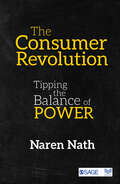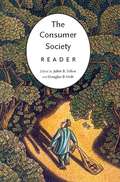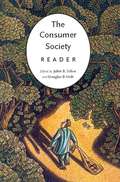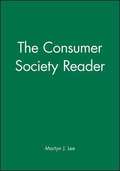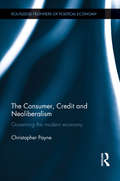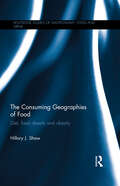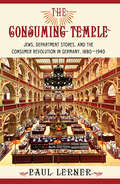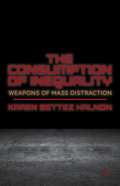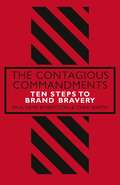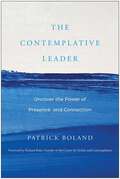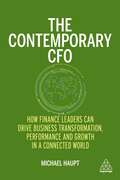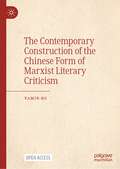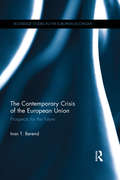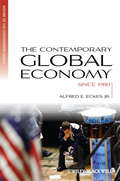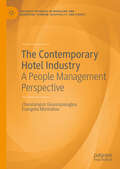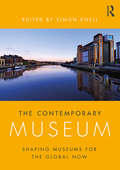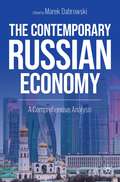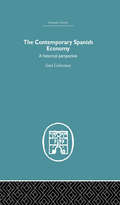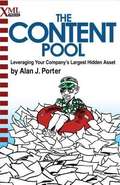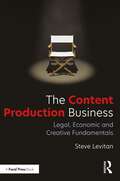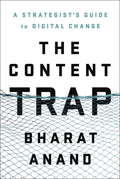- Table View
- List View
The Consumer Revolution: Tipping the Balance of Power
by Naren NathIn this ground breaking book, Naren Nath provides a sweeping narrative of revolutions since the dawn of human civilization, leading up to the current and most impactful of them all—the consumer revolution. The book paints a gripping picture of consumers melding together, akin to nuclear fusion, to unleash unprecedented amount of energy and creativity, setting in motion a stunning transfer of power from traditional institutions. In doing so, it tosses up myriad new business ideas, and also highlights some of the sinister implications if the revolution is not harnessed correctly. The Consumer Revolution provides a fascinating context and rationale for some of the biggest current events and trends around the world. It is a stirring call for action to billions of everyday consumers to express their will and wield power in this ultimate doctrine of consumer empowerment.
The Consumer Society Reader
by Juliet Schor D. B. HoltThe Consumer Society Reader features a range of key works on the nature and evolution of consumer society. Included here is much-discussed work by leading critics such as Jean Baudrillard, Susan Bordo, Dick Hebdige, bell hooks, and Janice Radway. Also included is a full range of classics, such as Frankfurt School writers Adorno and Horkheimer on the Culture Industry; Thorstein Veblen's oft-cited writings on "conspicuous consumption"; Betty Friedan on the housewife's central role in consumer society; John Kenneth Galbraith's influential analysis of the "affluent society"; and Pierre Bourdieu on the notion of "taste.""Consumer society--the 'air we breathe,' as George Orwell has described it--disappears during economic downtruns and political crises. It becomes visible again when prosperity seems secure, cultural transformation is too rapid, or enviornmental disasters occur. Such is the time in which we now find ourselves. As the roads clog with gas-guzzling SUVs and McMansions proliferate in the suburbs, the nation is once again asking fundamental questions about lifestyle. Has 'luxury fever,' to use Robert Frank's phrase, gotten out of hand? Are we really comfortable with the 'Brand Is Me' mentality? Have we gone too far in pursuit of the almighty dollar, to the detriment of our families, communities, and natural enviornment? Even politicians, ordinarily impermeable to questions about consumerism, are voicing doubts... [and] polls suggest majorities of Americans feel the country has become too materialistic, too focused on getting and spending, and increasingly removed from long-standing non-materialist values." -From the introduction by Douglas B. Holt and Juliet B. Schor
The Consumer Society Reader
by Juliet Schor D. B. HoltThe Consumer Society Reader features a range of key works on the nature and evolution of consumer society. Included here is much-discussed work by leading critics such as Jean Baudrillard, Susan Bordo, Dick Hebdige, bell hooks, and Janice Radway. Also included is a full range of classics, such as Frankfurt School writers Adorno and Horkheimer on the Culture Industry; Thorstein Veblen's oft-cited writings on "conspicuous consumption"; Betty Friedan on the housewife's central role in consumer society; John Kenneth Galbraith's influential analysis of the "affluent society"; and Pierre Bourdieu on the notion of "taste.""Consumer society--the 'air we breathe,' as George Orwell has described it--disappears during economic downtruns and political crises. It becomes visible again when prosperity seems secure, cultural transformation is too rapid, or enviornmental disasters occur. Such is the time in which we now find ourselves. As the roads clog with gas-guzzling SUVs and McMansions proliferate in the suburbs, the nation is once again asking fundamental questions about lifestyle. Has 'luxury fever,' to use Robert Frank's phrase, gotten out of hand? Are we really comfortable with the 'Brand Is Me' mentality? Have we gone too far in pursuit of the almighty dollar, to the detriment of our families, communities, and natural enviornment? Even politicians, ordinarily impermeable to questions about consumerism, are voicing doubts... [and] polls suggest majorities of Americans feel the country has become too materialistic, too focused on getting and spending, and increasingly removed from long-standing non-materialist values." -From the introduction by Douglas B. Holt and Juliet B. Schor
The Consumer Society Reader
by Juliet B. Schor Douglas B. HoltThis books features a range of key discussions about consumer society. Included are much-discussed work by leading ritics such as Jean Baudrillard, Susan Bordo, Dick hebdige, bell hooks, and Janice Radway. Also included are a full range of classics, such as Frankfurt School writers Adorno and Horkheimer on the Culture Industry; Thorstein Veblen's oft-cited writings on "conspicuous consumption"; Betty Friedan on the housewife's central role in consumer society; John K. Galbraith's influential analysis of the "affluent society"; and Pierre Bourdieu on the notion of "taste".
The Consumer Society Reader
by Douglas B. Holt Juliet SchorThe Consumer Society Reader features a range of key works on the nature and evolution of consumer society. Included here is much-discussed work by leading critics such as Jean Baudrillard, Susan Bordo, Dick Hebdige, bell hooks, and Janice Radway. Also included is a full range of classics, such as Frankfurt School writers Adorno and Horkheimer on the Culture Industry; Thorstein Veblen's oft-cited writings on "conspicuous consumption"; Betty Friedan on the housewife's central role in consumer society; John Kenneth Galbraith's influential analysis of the "affluent society"; and Pierre Bourdieu on the notion of "taste.""Consumer society--the 'air we breathe,' as George Orwell has described it--disappears during economic downtruns and political crises. It becomes visible again when prosperity seems secure, cultural transformation is too rapid, or enviornmental disasters occur. Such is the time in which we now find ourselves. As the roads clog with gas-guzzling SUVs and McMansions proliferate in the suburbs, the nation is once again asking fundamental questions about lifestyle. Has 'luxury fever,' to use Robert Frank's phrase, gotten out of hand? Are we really comfortable with the 'Brand Is Me' mentality? Have we gone too far in pursuit of the almighty dollar, to the detriment of our families, communities, and natural enviornment? Even politicians, ordinarily impermeable to questions about consumerism, are voicing doubts... [and] polls suggest majorities of Americans feel the country has become too materialistic, too focused on getting and spending, and increasingly removed from long-standing non-materialist values." -From the introduction by Douglas B. Holt and Juliet B. Schor
The Consumer Society Reader
by Martyn J. LeeThe Consumer Society Reader is the most substantial collection of classic and contemporary readings on consumption and consumer society for students of cultural studies and sociology of culture. From Karl Marx to Jean Baudrillard, the volume introduces students and researchers to the topics, themes, and preoccupations of twentieth-century consumer culture.
The Consumer, Credit and Neoliberalism: Governing the Modern Economy (Routledge Frontiers Of Political Economy Ser. #152)
by Christopher PayneThis book is an investigation into the economic policy formulation and practice of neoliberalism in Britain from the 1950s through to the financial crisis and economic downturn that began in 2007-8. It demonstrates that influential economists, such as F.A. Hayek and Milton Friedman, authors at key British think tanks such as the Institute of Economic Affairs and the Centre for Policy Studies, and important political figures of the Thatcher and New Labour governments shared a similar conception of the consumer. For neoliberals, the idea that consumers were weak in the face of businesses and large corporations was almost offensive. Instead, consumers were imagined to be sovereign agents in the economy, whose consumption decisions played a central role in the construction of their human capital and in the enabling of their aspirations. Consumption, just like production, came to be viewed as an enterprising and entrepreneurial activity. Consequently, from the early 1980s until the present day, it was felt necessary that banks should have the freedom to meet the borrowing needs of consumers. Credit rationing would be a thing of the past. Just like businesses, consumers and households could use debt to expand their stock of personal assets. By utilizing the method of French philosopher Michel Foucault this book provides an original analysis of the policy ideas and political speeches of key figures in the New Right, in government and at the Bank of England. And it addresses the key question as to why policy-makers both in Britain and the United States did little or nothing to stem rising consumer and household indebtedness, instead always choosing to see increasing house prices and homeownership as a positive to be encouraged.
The Consuming Geographies of Food: Diet, Food Deserts and Obesity (Routledge Studies of Gastronomy, Food and Drink)
by Hillary J. ShawThe consumption and distribution of food, as well as its production, has become a major public policy issue over the past few decades; what we eat is no longer merely a private matter but carries significant externalities for wider society. Its increasing significance within the public arena implies a dissonance regarding the boundaries of food; where do we draw the line between food as private and food as public? What are the rights of society to impinge upon individual food consumption, and what conflicts will ensue when this boundary is disputed? The Consuming Geographies of Food explores these multiple issues of food across different regions of the world from the consumer’s perspective. It uniquely explicates the factors that lead customers towards certain typologies of consumption and towards certain types of retailing, offering a comprehensive review of the obesity problem, the phenomenon of food deserts and the issue of exclusion from a healthy diet. It then considers the effects of food on the consumer, the dynamic relationship between food and people, and the issue of food exclusion before concluding with possible futures for food consumption, from low-technology projects to high-technology scenarios. Based on original research into food access, ethics and consumption in both developed and less-developed countries this book will be of interest to students, researchers and academics in the fields of geography, economics, hospitality health, marketing, nutrition and sociology.
The Consuming Temple: Jews, Department Stores, and the Consumer Revolution in Germany, 1880–1940
by Paul LernerDepartment stores in Germany, like their predecessors in France, Britain, and the United States, generated great excitement when they appeared at the end of the nineteenth century. Their sumptuous displays, abundant products, architectural innovations, and prodigious scale inspired widespread fascination and even awe; at the same time, however, many Germans also greeted the rise of the department store with considerable unease. In The Consuming Temple, Paul Lerner explores the complex German reaction to department stores and the widespread belief that they posed hidden dangers both to the individuals, especially women, who frequented them and to the nation as a whole.Drawing on fiction, political propaganda, commercial archives, visual culture, and economic writings, Lerner provides multiple perspectives on the department store, placing it in architectural, gender-historical, commercial, and psychiatric contexts. Noting that Jewish entrepreneurs founded most German department stores, he argues that Jews and “Jewishness” stood at the center of the consumer culture debate from the 1880s, when the stores first appeared, through the latter 1930s, when they were “Aryanized” by the Nazis. German responses to consumer culture and the Jewish question were deeply interwoven, and the “Jewish department store,” framed as an alternative and threatening secular temple, a shrine to commerce and greed, was held responsible for fundamental changes that transformed urban experience and challenged national traditions in Germany’s turbulent twentieth century.
The Consumption of Inequality: Weapons of Mass Distraction
by Karen Bettez HalnonThe fads, fashions, and media in popular consumer culture frequently make recreational and ideological "fun" of poverty and lower class living. In this book, Halnon delineates how incarceration, segregation, stigmatization, cultural and social consecration, and carnivalization work in the production and consumption of inequality.
The Contagious Commandments: Ten Steps to Brand Bravery
by Paul Kemp-Robertson Chris BarthContagion may alarm doctors but marketers thrive on it. Some concepts are so compelling you have to share them. But what makes an idea so infectious you can't keep it to yourself? And how can brands produce these kinds of ideas intentionally rather than by chance?Contagious, the globally renowned intelligence resource for the marketing industry, is dedicated to identifying and interrogating the world's most exceptional creative trends. And in The Contagious Commandments, Paul Kemp-Robertson and Chris Barth condense this valuable research into ten strategic takeaways for your own marketing revolution.Taking inspiration from disruptive campaigns from the likes of Patagonia, Nike, Safaricom, BrewDog, LEGO, Kenco, and dozens more, The Contagious Commandments explores how companies fuse creativity, technology and behavioural psychology to achieve truly original marketing ideas that have a positive impact on society and profits - and how your brand can too.
The Container Store
by Aldo Sesia Zeynep Ton Tatiana SandinoThe Container Store (TCS) is a Texas-based retailer of organization and storage solutions. The company prides itself in taking care of its employees first and its co-founder and CEO Kip Tindell practices Conscious Capitalism. Since it beginnings in 1978, TCS grew to a chain of around 70 stores located in over 20 states by 2013. Tindell believed TCS's employee-first culture and the seven Foundation Principles, which guided the company, were what differentiated the company from other retailers. With plans to grow to 300 stores, TCS went public in late 2013. Since its IPO same store sales have suffered and the company's stock in early 2016 was trading well below its IPO price. As such, the company's culture and Foundation Principles were being put to the test.
The Contemplative Leader: Uncover the Power of Presence and Connection
by Patrick BolandThe most effective leaders are deeply aware of how their presence impacts every dimension of their leadership. This guide shows leaders in any organization how to move beyond the daily noise of your environment and connect with people to bring about change where it matters most. Featuring interviews with world-renowned leaders, from Richard Rohr (contemplative teacher) to Margaret Wheatley (author of Leadership and the New Science) and Matthew McCarthy (former CEO of Ben & Jerry&’s), this book provides a framework for understanding how best to connect with who we are and with those whom we lead. In The Contemplative Leader, psychotherapist, leadership consultant, and executive coach Patrick Boland integrates ancient wisdom with scientific research. He introduces psychological models, anecdotes, reflective questions, and innovative practices that outline how to: Re-envision leadership as something that takes account of the breadth of human experience Uncover the narratives that have shaped us so we can embrace our whole self (false self and true self) Focus on both the financials and the people, the results and the road that gets us there, the personal benefits and the impact on the wider organization and community Whether you are a seasoned leader in need of a reset to connect with what&’s most important, new to leadership and looking for some &“soul&” work to do to develop authentic influence, or seeking to integrate beneficial practices into your active roles inside and outside of work, The Contemplative Leader is a comprehensive guide to shaping relationships and systems to use your power and influence for good.
The Contemplative Practitioner
by John P. MillerMeditation is a simple and practical activity that can enrich our lives and work in innumerable ways. It allows us to connect more deeply to ourselves and others and to the environment. In this book, John P. Miller, an expert in the field of holistic education, looks at mediation and how it can be integrated into one's work and daily life.Twenty years after it was first published, Miller's book remains one of the best guides to applying contemplative practice, covering a variety of theoretical, empirical, historical, and cross-cultural approaches. For this new edition, Miller has updated the text to reflect the growth of the mindfulness movement, new research into the brain, and his years of experience teaching and practising contemplation in teacher education.Whether one is interested in exploring how meditation can be used in the classroom or the workplace, or simply seeking to integrate it into one's personal life, The Contemplative Practitioner is the perfect companion.
The Contemporary CFO: How Finance Leaders Can Drive Business Transformation, Performance and Growth in a Connected World
by Michael HauptThe digital revolution is changing our world and the fundamentals of business faster than anyone expected, and the responsibility for leading key aspects of enterprise-wide business transformation often falls to the Chief Financial Officer (CFO). This book provides motivation and guidance for current and future finance leaders to navigate an increasingly unpredictable, dynamic, complex and connected world. As businesses are forced to change fundamentally or accept the reality of being left behind, the CFO has a particularly important part to play in preparing for this change - not only for their own function but for the business as a whole. So what is the role of CFOs in delivering digital business transformation? What can they do to manage business resources and performance more dynamically? How can CFOs contribute to the creation and management of new business models, such as digital business platforms and ecosystems? And what can finance leaders do to enable sustainable growth and long-term multi-stakeholder value creation?These and many more key questions are tackled in The Contemporary CFO, which draws on practical experience of transforming leading global businesses and on extensive, original research, including in-depth interviews with a wide range of corporate leaders. CFOs are used to managing change but delivering a complex business transformation on top of an already demanding role can be challenging. This essential guide includes the latest thinking, trends and perspectives to help finance leaders navigate the demands of the connected world successfully.
The Contemporary Construction of the Chinese Form of Marxist Literary Criticism
by Yamin HuThis is an open access book. This book is the first comprehensive and systematic study on the Chinese Marxist literary criticism as an independent theoretical form. It discusses and describes the theoretical features of the Chinese form of Marxist literary criticism by refining and re-interpreting the iconic key concepts of “people,” “nation,” “politics,” “praxis,” and the relationships between literature and high-tech, literature and capital. The value judgment of literary criticism has also been discussed at length, and insightful and valuable views have been provided. This book is a brilliant introduction and the ideal academic material for global readers to grasp the essence of Chinese Marxist literary thoughts.
The Contemporary Crisis of the European Union: Prospects for the future (Routledge Studies in the European Economy)
by Ivan T. BerendThe European Union widened and deepened integration when it introduced the Single Market and the common currency, increasing the number of member countries from 12 to 28. After a quarter of a century, the 2008 financial and economic crisis opened a new chapter in the history of European integration. Prosperity was replaced by economic crisis and then long stagnation, with ramifications far beyond the economic arena. For the first time, after more than half a century, some countries were almost forced to step out of the Union. History’s most frightening migration crisis shocked Europe and led to the strengthening of several anti-integration parties in various countries. This pioneering book discusses the nine crisis elements that could lead to disintegration of the EU. Beginning with the Greek Debt disaster this book delves into the cause of the recent European crisis and then onto the recent immigration influx and its consequences, as well as Britain’s exit from the Union. A concluding chapter, based on the facts of positive development during the crises years, gives a cautiously optimistic forecast for the future and asks the question: further integration or disintegration? This volume is of great importance to academics, students and policy makers who have an interest in European politics, political economy and migration.
The Contemporary Global Economy: A History since 1980 (Blackwell History Of The Contemporary World Ser. #9)
by Alfred E. Eckes Jr.The Contemporary Global Economy provides a lively overview of recent turbulence in the world economy, focusing on the dynamics of globalization since the 1980s. It explains the main drivers of economic change and how we are able to discern their effects in the world today. A lucid and balanced survey, based on extensive research in data and documents, accessible to the non-specialist Written by a renowned specialist in international economic relations with academic and government credentials Offers clear and engaging explanations of the main motors of economic change and how we are able to discern their effects in the world today The author assumes little knowledge of economic theory or financial markets Identifies the challenges for sustainable recovery and economic growth in the years ahead
The Contemporary Hotel Industry: A People Management Perspective (Palgrave Advances in Managing and Marketing Tourism, Hospitality, and Events)
by Charalampos Giousmpasoglou Evangelia MarinakouThis book provides a detailed account of the global hotel industry with a focus on managerial work and people management. A comprehensive understanding of the managers' work from a people management perspective is essential to the success of hotel operations; however, this is an area that has been under-researched.Based on existing literature and extensive research carried out by the authors over fifteen years, the book explores the different aspects of managerial work in global hotel industry settings and covers topics such as general management, leadership, education and training, skills and competencies, crisis management, and managing diversity. The book’s findings suggest that hotel managers should adopt a people-centric management and leadership style while at the same time maintaining operational efficiency.A unique book in terms of scale and depth, it offers useful insights into both theoretical and practical perspectives.
The Contemporary Museum: Shaping Museums for the Global Now
by Simon KnellThe Contemporary Museum issues a challenge to those who view the museum as an artefact of history, constrained in its outlook as much by professional, institutional and disciplinary creed, as by the collections it accumulated in the distant past. Denying that the museum can locate its purpose in the pursuit of tradition or in idealistic speculation about the future, the book asserts that this can only be found through an ongoing and proactive negotiation with the present: the contemporary. This volume is not concerned with any present, but with the peculiar circumstances of what it refers to as the ‘global contemporary’ – the sense of living in a globally connected world that is preoccupied with the contemporary. To situate the museum in this world of real and immediate need and action, beyond the reach of history, the book argues, is to empower it to challenge existing dogmas and inequalities and sweep aside old hierarchies. As a result, fundamental questions need to be asked about such things as the museum’s relationship to global time and space, to systems and technologies of knowing, to ‘the life well lived’, to the movement and rights of people, and to the psychology, permanence and organisation of culture. Incorporating diverse viewpoints from around the world, The Contemporary Museum is a follow-up volume to Museum Revolutions and, as such, should be essential reading for students in the fields of museum and heritage studies, cultural studies, communication and media studies, art history and social policy. Academics and museum professionals will also find this book a source of inspiration.
The Contemporary Russian Economy: A Comprehensive Analysis
by Marek DabrowskiThis textbook offers a wide-ranging, comprehensive analysis of the contemporary Russian economy (as it functions in the early 2020s) concentrated on the economy, economic policy, and economic governance. Chapters cover recent Russian economic history, the economic geography of Russia, natural resources, population, major sectors and industries, living standards and social policy, institutions, governance, economic policy, and Russia's role in the global economy. The book will provide a comparative cross-country context, analysing how the Russian economy and its institutions perform compared to its peers to help students and instructors understand Russia’s strengths, weaknesses, and future challenges. Prepared by a team of leading Russian and international experts on the respective topics, this textbook will be of interest to those studying Russian economics. It will be valuable reading for undergraduate and graduate students of Russian studies, the Russian economy, Russian politics, the economics of transition, the economics of emerging markets, and international relations.
The Contemporary Spanish Economy: A Historical Perspective
by Sima liebermanFirst Published in 2005. Routledge is an imprint of Taylor & Francis, an informa company.
The Content Pool
by Alan J. PorterAll companies, no matter what industry they are in, or what product or service they create, do four basic things. Offer something for sale, sell it, collect money for it, and create content about what they do. Product development, Marketing, Sales, and Finance are all essential to the organization and are typically managed at the VP or CXO level, yet a company's content, which contains all of its intellectual property, is often overlooked. The Content Pool: Leveraging Your Company's Largest Hidden Asset makes the case for placing content creation, management, and distribution on a par with other core strategic business activities. Inside the Book Identifying Your Content Organizing Your Content Managing Your Content Leveraging Your Content The Case for a Chief Content Officer Bibliography and Index
The Content Production Business: Legal, Economic and Creative Basics for Producers
by Steve LevitanThis book goes beyond the technical steps in the process of making film, TV, and media material, examining what it means to be an ongoing supplier of content to the marketplace and how to become one. Steve Levitan brings insights and experience from his lifelong career producing in the content industry, where he has also acted as a professional advisor to content makers, distributors and providers, whilst setting up his own production company. Producing as a Business offers strategic, tactical, financial, legal and marketing insights for the successful establishment of content creation enterprises. Readers will gain insight into how to avoid starting from square one with each project, while also learning how to maintain a meaningful level of ownership and build a revenue stream that can sustain a core operation, helping establish them as a “player” in the industry. This text is aimed at the international production industry, with real examples referred to throughout. Film, television, and media production students who are looking to understandthe business of producing, as well as first-time producers who are already familiar with the basics of the production process, will benefit from an examination of the building blocks that form lasting production companies.
The Content Trap: A Strategist's Guide to Digital Change
by Bharat Anand"As Bharat Anand shows in this eminently readable book, connections are now more important than content."--Daniel H. Pink, author of Drive and To Sell Is Human Harvard Business School Professor of Strategy Bharat Anand presents an incisive new approach to digital transformation that favors fostering connectivity over focusing exclusively on content. Companies everywhere face two major challenges today: getting noticed and getting paid. To confront these obstacles, Bharat Anand examines a range of businesses around the world, from The New York Times to The Economist, from Chinese Internet giant Tencent to Scandinavian digital trailblazer Schibsted, and from talent management to the future of education. Drawing on these stories and on the latest research in economics, strategy, and marketing, this refreshingly engaging book reveals important lessons, smashes celebrated myths, and reorients strategy. Success for flourishing companies comes not from making the best content but from recognizing how content enables customers' connectivity; it comes not from protecting the value of content at all costs but from unearthing related opportunities close by; and it comes not from mimicking competitors' best practices but from seeing choices as part of a connected whole. Digital change means that everyone today can reach and interact with others directly: We are all in the content business. But that comes with risks that Bharat Anand teaches us how to recognize and navigate. Filled with conversations with key players and in-depth dispatches from the front lines of digital change, The Content Trap is an essential new playbook for navigating the turbulent waters in which we find ourselves.Advance praise for The Content Trap"As Bharat Anand shows in this eminently readable book, connections are now more important than content. His insights will bring you several steps closer to understanding the digital revolution and how you can avoid its many perils."--Daniel H. Pink, New York Times bestselling author of Drive and To Sell Is Human"A very smart book--creators, ignore this at your peril. This revolution has been twenty years in the making, and Bharat Anand makes the past (and the future) a lot more clear."--Seth Godin, New York Times bestselling author of Meatball Sundae and Linchpin"Bharat Anand has written the rarest of books, one that combines deep strategic insight with great practical impact. The Content Trap is both a delight to read and the essential book for understanding today's digital revolution. In the process, Anand debunks the conventional wisdom time and time again; his insights are sharp, perceptive, and strikingly original."--David Garvin, C. Roland Christensen Professor of Business Administration, Harvard Business School"'Content is king' may once have been true, but favoring content over connections will only get you dethroned today. In clear and compelling prose, Anand shows us how to lay the strategy groundwork to thrive in an increasingly connected world. Understanding the Content Trap is the true solution to your digital dilemma!"--Barry Nalebuff, Milton Steinbach Professor, Yale School of Management, co-author of Why Not? and Co-opetition, and co-founder of Honest TeaFrom the Hardcover edition.
